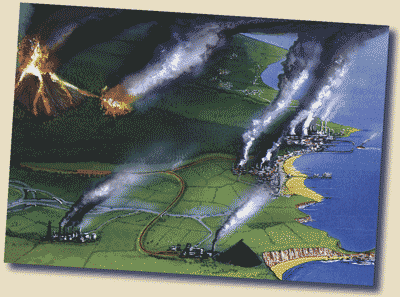|
||||||||||
|
|||||||||
| Questions/instructions:
|
|||||||||
| %
responses |
|||||||||
| 1.
Whakaingoatia kia whä ngä mea e tuku ana i
te kapuni ki te taiao. Name four things in the picture that add gases into the air. |
volcano
|
59 |
|||||||
forest
fire |
46 |
||||||||
factories/chimneys/smoke/city
buildings |
52 |
||||||||
trains
|
22 |
||||||||
cars/buses/trucks
|
26 |
||||||||
boats/ships
|
43 |
||||||||
houses
|
17 |
||||||||
people/animals
|
17 |
||||||||
other
valid response |
0 |
||||||||
| 2.
He aha ëtahi raruraru ka puta mënä ka mahana haere tö
tätou ao? What problems might happen if planet Earth gets hotter? |
melting
of polar ice caps and snow/ice on mountains |
2 |
|||||||
sea
levels rising |
4 |
||||||||
low
lying islands and coasts submerged, flooded |
4 |
||||||||
changes
in weather patterns |
15 |
||||||||
changes
in plant and animal species |
30 |
||||||||
increased
exposure to UV rays (associated with increase in skin disease) |
22 |
||||||||
other
valid response |
0 |
||||||||
| 3.
Arä ëtahi tängata e whakahau ana kia whakaitia te tuku
kapuni ki te taiao. Me pëhea e tutuki ai tënei whakaaro? Some people want us to cut down the amount of gases going into the air. How do you think this could be done? |
reduce
emissions from fires (domestic) and factories
|
11 |
|||||||
reduce
emissions by engines burning fossil fuel (including use of car pooling, public transport) |
11 |
||||||||
change
numbers of animals or their diet (or genetics)
|
2 |
||||||||
reduce
production and use of specialised gases (e.g. aerosols) |
13 |
||||||||
absorb
undesirable gases (e.g. plant trees)
|
0 |
||||||||
other
valid responses |
4 |
||||||||
Total
score: |
8 or more |
2 |
|||||||
6–7
|
22 |
||||||||
4–5
|
30 |
||||||||
2–3
|
37 |
||||||||
0–1
|
9 |
||||||||
| Commentary: Most students could identify one or more sources of atmospheric gases, but very few indicated more than one consequence of the earth getting warmer, and less than half identified any strategy for reducing omissions of atmospheric gases. |
|||||||||
|
|
|
|
